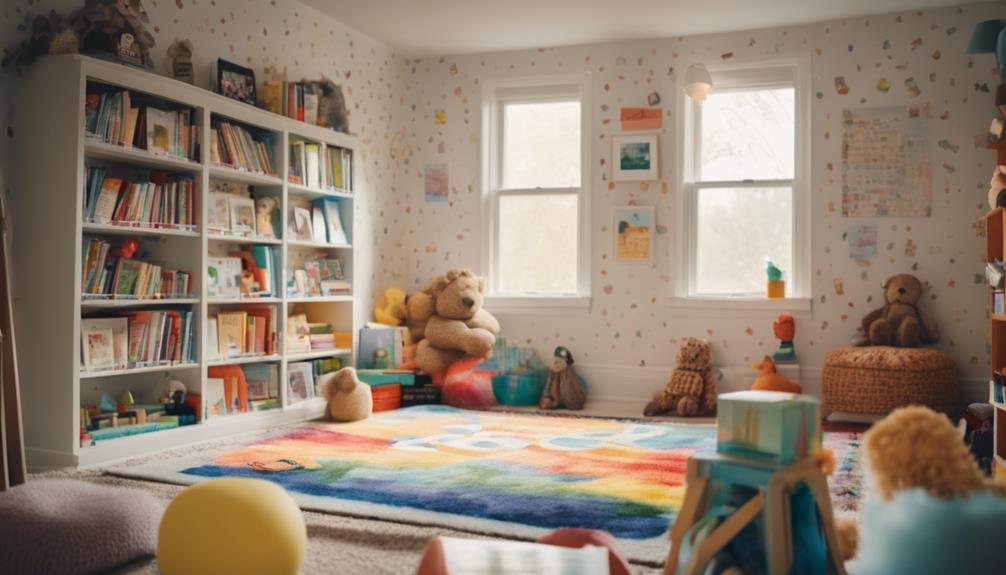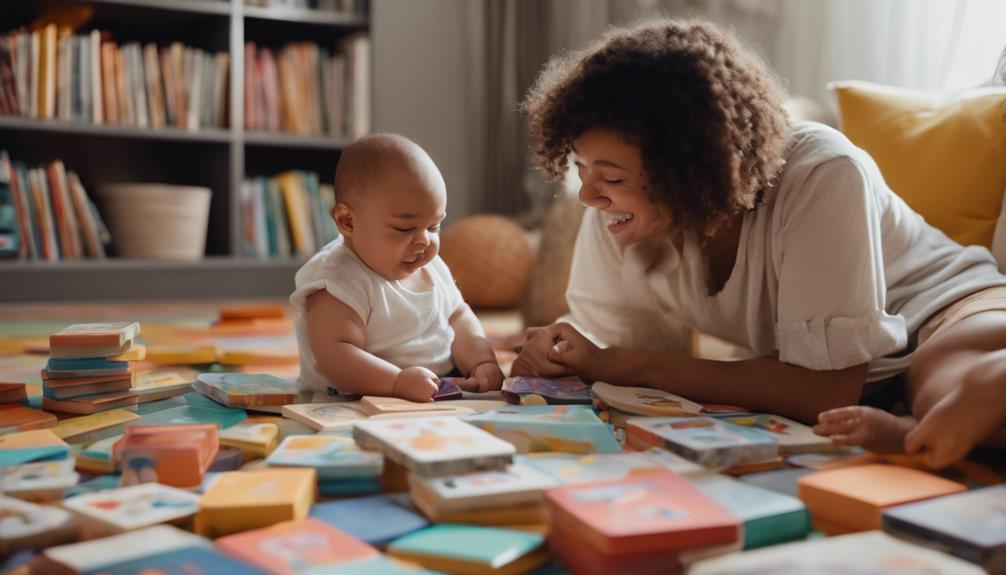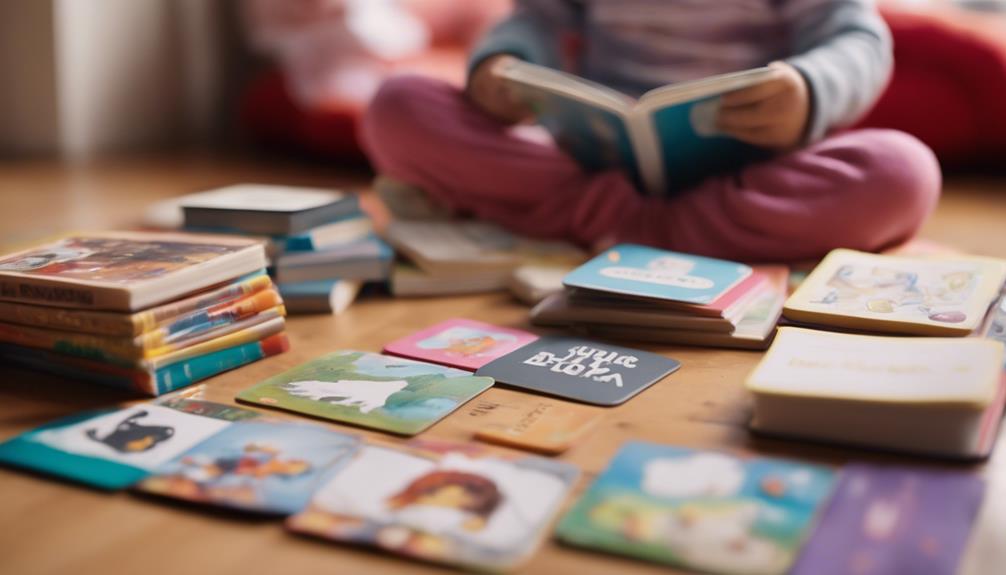Teaching your baby to read could significantly enhance their brain development and language skills, setting the stage for a successful learning journey. By utilizing methods such as the Doman method, employing word cards and picture books, and setting up a peaceful reading area, you can establish an optimal learning environment. Limiting exposure to excessive technology may improve focus and understanding. Resources like ‘How To Teach Your Baby To Read’ by Glenn Doman & Janet Doman provide useful step-by-step instructions. These techniques are designed to make learning enjoyable and efficient. Delve deeper into the various strategies and tools available to support your baby’s reading progress.
Key Takeaways
- Start with high-contrast flashcards.
- Introduce words slowly and repeat often.
- Use engaging picture books.
- Incorporate reading into daily routines.
- Make learning fun and praise progress.
Importance of Teaching Baby Reading
Teaching your baby to read is vital for enhancing brain development and language acquisition during the early years of life.
The ability to teach children how to read from a young age provides them with a solid foundation for learning and understanding the world around them.
As a parent, you play an important role in shaping your child's learning journey by introducing them to the wonders of reading.
Benefits of Early Reading

Enhancing brain development and language skills, early reading instruction offers numerous benefits to young children. Teaching your baby to read not only aids in language acquisition and vocabulary expansion but also fosters a love for reading from a very early age. Babies and young children possess a remarkable capacity to absorb new information, making early literacy development highly effective. By introducing reading at a young age, you're laying a strong foundation for your child's future academic success.
Moreover, early reading instruction has been linked to enhanced brain development in children from birth to six years old. This early exposure to reading can help stimulate cognitive growth and critical thinking skills. Additionally, starting early with reading can instill a lifelong passion for learning and exploration in your child.
Best Practices for Teaching Reading

What're the most effective methods for introducing reading to young children? When teaching your baby to read, consider using the Doman method, which involves using plastic letters and flashcards to introduce words. This method focuses on word recognition rather than phonics for early literacy instruction. It's important to start teaching children to read at a young age to optimize learning and brain development.
Additionally, encourage reading picture books and ask questions to enhance comprehension. Utilizing flashcards with words or letters can help children associate symbols with sounds and meanings, aiding in their reading development. Reading picture books not only exposes children to language but also sparks their imagination and curiosity. Asking questions about the book can enhance their understanding and critical thinking skills.
Remember to monitor your child's progress and adapt your teaching methods accordingly to suit their readiness and learning style. By incorporating these practices into your reading sessions, you can create a nurturing environment that fosters a love for books and learning in your child.
Setting the Right Environment

Create a cozy and distraction-free reading area for your baby to cultivate a love for books and learning. Guarantee the environment is quiet and comfortable, free from interruptions. Natural or soft lighting can help establish a soothing atmosphere during reading sessions. Fill the space with age-appropriate books and reading materials to ignite your baby's interest. Consider adding cozy seating options like cushions or bean bags for a relaxed reading experience.
When teaching your baby to read, interactive reading is crucial. Engage your baby by asking questions, pointing out pictures, and involving them in the story. Make reading sessions enjoyable and engaging to keep your baby interested and enthusiastic to learn.
Reading word cards together can also be a fun and effective way to introduce new words and concepts. By setting the right environment, you can create a positive and nurturing space that fosters your baby's curiosity and love for reading.
Avoiding Technology in Reading Instruction

To foster a more traditional and focused approach to reading instruction, consider avoiding the use of technology in your child's learning journey. When it comes to teaching your baby to read, sticking to traditional methods can have significant benefits.
Here are a few reasons why avoiding technology in reading instruction is advantageous:
- Enhanced Focus: By eliminating technological distractions, children can concentrate more on the reading material at hand.
- Improved Comprehension: Limiting screen time and utilizing tools like books and flashcards can boost reading comprehension and retention.
- Hands-On Learning: Technology-free reading instruction encourages physical interaction with reading materials, promoting a more tactile and engaging learning experience.
Role of Parents in Reading Development

Parents play a vital role in fostering your baby's reading development. By creating a reading-friendly environment and engaging in consistent reading practices, you can help your child build essential language and literacy skills.
Establishing a routine of reading to your baby from an early age lays a strong foundation for their cognitive growth and future academic success.
Parental Guidance Importance
Guidance from caregivers plays an important role in nurturing a child's early reading skills. When you teach your niece to read, your involvement as a parent or caregiver is essential for her reading development.
Here are three reasons why parental guidance is necessary:
- Creating a Supportive Environment: By establishing a nurturing and engaging atmosphere for learning, you can help your niece feel encouraged and motivated to explore reading.
- Fostering a Love for Reading: Your guidance can instill a love for books and storytelling in your niece from a young age, setting the foundation for a lifelong passion for reading.
- Utilizing Effective Methods: Implementing techniques like the Doman method can help you introduce words and language concepts to your niece in a way that's both engaging and effective.
Reading Environment Setup
Creating a cozy and inviting reading space for your baby can greatly influence their reading development. To foster a love for books and learning, make sure the reading area is comfortable and well-lit. Surround your baby with a variety of reading materials such as board books, picture books, and touch-and-feel books to engage their senses and curiosity. Reading aloud to your baby regularly not only enhances their language skills but also strengthens the bond between you and your child.
Model positive reading behaviors by showing enthusiasm for books and reading in front of your baby. Your attitude towards reading can have a big impact on their perception of books.
Consistent Reading Practices
To help your baby develop strong reading skills, maintaining consistent reading practices is crucial in fostering their language acquisition and literacy foundation. Consistent reading practices at a young age play an essential role in helping babies recognize words and develop language skills.
Here are three essential points to keep in mind:
- Regular Reading Sessions: Reading to your baby on a consistent basis helps create a routine that promotes language development and strengthens the parent-child bond.
- Interactive Reading Activities: Incorporating interactive elements like pointing to pictures, asking questions, and using different voices during reading sessions can enhance your baby's engagement and comprehension skills.
- Establishing a Reading Routine: Setting aside dedicated time each day for reading helps in building your baby's vocabulary, fostering a love for books, and improving their overall literacy skills.
Recommended Reading Tools

When it comes to teaching your baby to read, having the right tools can make a significant difference in their learning journey.
Interactive learning materials, such as word cards and children's books, provide a hands-on approach that engages your baby's senses and promotes active participation in the learning process.
These tools are designed to enhance your baby's reading skills and create a fun and educational experience for both you and your little one.
Tools for Reading
Consider utilizing the book 'How To Teach Your Baby To Read' by Glenn Doman & Janet Doman as a recommended reading tool for teaching your baby to read effectively. This book, a valuable resource for millions of parents worldwide since 1963, provides a detailed guide to starting babies on a path to intellectual excellence.
The third edition covers all necessary information and techniques for successful teaching. The Deluxe Program, associated with the book, includes word cards, a children's book, a Certificate of Achievement, and instructional materials for parents.
- The book has a proven track record of success in teaching babies to read effectively.
- It has received accolades, including the 'Award on the Day', making it a highly recommended tool for parents.
- The Deluxe Program offers additional resources for a more interactive and engaging learning experience.
Interactive Learning Materials
For parents looking to engage their babies in interactive learning experiences, recommended reading tools such as word cards and children's books can play an essential role in fostering early literacy skills.
Word cards with large, clear letters, colorful images, and simple words help babies recognize and learn new vocabulary. These tools are designed to make the learning process fun and interactive, stimulating your baby's interest in reading and storytelling.
Children's books included in the program aim to engage babies in the process of learning to read, making it an enjoyable experience.
Instructional materials also provide valuable guidance for parents on how to effectively use these tools to teach their babies to read. By incorporating these interactive learning materials into your baby's routine, you can create a stimulating environment that encourages early literacy development and sets a strong foundation for future academic success.
Maximizing Learning With Programs

Enhancing your baby's learning potential through specialized programs can greatly boost their early literacy skills. These programs are designed to provide parents with the tools and guidance needed to kickstart their baby's reading journey effectively.
Here are three key ways you can maximize learning with programs:
- Step-by-Step Guidance: Programs like 'How To Teach Your Baby To Read' offer structured approaches that break down the teaching process into manageable steps, making it easier for you to navigate through the program.
- Effective Materials: These programs provide word cards, children's books, and other instructional tools that are specifically tailored to enhance your baby's reading abilities, ensuring a well-rounded learning experience.
- Creating a Joyous Environment: The ultimate goal of these programs is to foster a positive and relaxed atmosphere for learning, where your baby can engage with reading in a fun and enjoyable way.
Frequently Asked Questions
What Age Should I Start Teaching My Baby to Read?
You should start teaching your baby to read as early as 6 months old to maximize their learning potential. Early exposure to reading greatly impacts language acquisition and brain development, laying a strong foundation for academic success.
How to Teach a Baby How to Read?
To teach a baby how to read, start by creating a loving environment. Use engaging tools like flashcards and observe their readiness. Just as a seed needs nurturing to bloom, your baby's literacy skills will grow with patience and practice.
How to Teach a Kid to Read Steps?
To teach a kid to read, start by introducing letters and sounds in fun ways. Use flashcards with words and pictures, read simple books together daily, and celebrate milestones. Keep them engaged and motivated.
What Is the Earliest Age to Start Reading?
You can start reading with your baby as early as six months. Their receptive minds absorb language effortlessly. Early reading builds a sturdy literacy foundation. Engage them with books, and watch their language skills flourish.
Conclusion
To sum up, teaching your baby to read can have numerous benefits for their cognitive development. By creating a nurturing environment, avoiding excessive use of technology, and actively engaging with your child in the reading process, you can help set the foundation for a lifetime of learning.
Remember, a love for reading is like a seed that, when planted early and nurtured with care, can blossom into a lifelong passion for knowledge and discovery.









